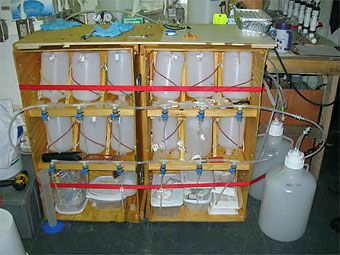

 | |||||||||
|
|
Journals 2008/2009John Karavias
July 4, 2008 After worrying about taking the O18 collection for Tom Weingartner, I collected it without incident and now I have the fever! Give me more! It was great to get involved and I thank Tom for having the confidence in me to take his samples.
Since it is the 4th of July, we had a barbeque on the ship and it was great. After the barbeque, I had two options. I could look for more fish larvae or whales. I chose whales. Pat hit the racks so I had some time to observe, so I hit the observation tower looking for mega fauna. Gary Friedrechsen, the marine mammal researcher, was welcoming to the company. After about 45 minutes I noticed what I thought to be a few whales. We had "blows" on our port side but Gary did not seem to get excited as he was looking to that side. After 30 seconds, I causally said to Gary, "Aren't those blows over there, Gary?" He looked and instantly got excited; however, I got more excited since this was my first whale sighting ever. He identified the four whales as fin whales by their tall colander blow 12 to 15 feet high. The dorsal fin is trigger shaped, which breeches slightly when the animal breathes. Gary estimated the two adults to be young and about 45 feet long. When Pat woke up, we finished cleaning the jugs and prepared them for our next Thorium sample. We also set up our satellite link for the sediment trap that we will deploy on Sunday, if all stays on schedule. As compared to yesterday, today was a much-needed "slower" day. ~~~~~~~
What am I doing with Pat Kelly? "Estimation of Primary Productivity and Particle Export Rates as a Function of Phytoplankton Community Structure in the Bering Sea"So what does that mean? Why do we want to do this? Questions we are trying to collect data to eventually answer: Where is the carbon going in the Bering Sea? Is it staying in the euphotic zone, or are the phytoplankton organisms that are absorbing the carbon dying and remineralizing and precipitating to the bottom shifting the carbon cycle to the benthos? How do we collect and begin to analyze our data? Once we have our 12 four liter bottle samples of water, the fun begins! We add Potassium Permanganate, Ammonium Hydroxide, and Manganese Chloride. This produces Manganese Oxide precipitate. The seawater solution is filtered through a one inch micron glass filter, which retains the precipitate. The reason we are doing this is to get the thorium that is in the water to adhere to the Manganese Oxide. Why do we want thorium? Thorium 234 has a 24 hour day half life These two elements behave differently and have different chemistries in seawater. Uranium is conservative, meaning it maintains proportionality with NaCl. Thorium sticks to particles meaning it is particle reactive. In short and oversimplifying to near inaccuracies, uranium decays to thorium and thorium levels tell us the particle flux which tells us the amount of organic carbon is being exported. Methods: By using a sediment trap we are able to "catch" the particle flux as it is precipitating, thus we know for sure it was precipitating. We deploy the trap for 20 to 24 hours to collect enough material for analysis. |
||||||||
